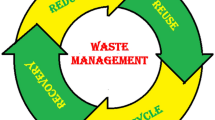Abstract
The leaf extract of Ocimum sanctum was used as a reducing agent for the synthesis of platinum nanoparticles from an aqueous chloroplatinic acid (H2PtCl6·6H2O). A greater conversion of platinum ions to nanoparticles was achieved by employing a tulsi leaf broth with a reaction temperature of 100 °C. Energy-dispersive absorption X-ray spectroscopy confirmed the platinum particles as major constituent in the reduction process. It is evident from scanning electron microscopy that the reduced platinum particles were found as aggregates with irregular shape. Fourier-transform infrared spectroscopy revealed that the compounds such as ascorbic acid, gallic acid, terpenoids, certain proteins and amino acids act as reducing agents for platinum ions reduction. X-ray diffraction spectroscopy suggested the associated forms of platinum with other molecules and the average particle size of platinum nanoparticle was 23 nm, calculated using Scherer equation. The reduced platinum showed similar hydrogen evolution potential and catalytic activity like pure platinum using linear scan voltammetry. This environmentally friendly method of biological platinum nanoparticles production increases the rates of synthesis faster which can potentially be used in water electrolysis applications.






Similar content being viewed by others
References
Govindaraju K, Tamilselvan S, Kiruthiga V, Singaravelu G (2010) J Biopest 3:394–399
Nanda A, Saravanan M (2009) Nanomedicine 5:452–456
Garima S, Riju B, Kunal K, Ashish RS, Rajendra PS (2010) J Nanopart Res 1–8. doi:10.1007/s11051-010-0193-y
Riddin T, Govender Y, Whiteley CG (2009) Enzym Microb Technol 45:267–273
Yageshni G, Tamsyn R, Mariekie G, Chris GW (2009) Biotechnol Lett 31:95–100
Yasuhiro K, Kaori O, Norizon S, Toshiyuki N, Shinsuke N, Hajime H et al (2007) J Biotechnol 128:648–653
Gardea TJL, Parsons JG, Gomez E, Peralta VJ, Troiani HE, Santiago P et al (2002) Nano Lett 2:397–401
Jae YS, Eun YK, Beom SK (2010) Bioprocess Biosyst Eng 33:159–164
Vineet K, Sudesh KY (2008) J Chem Technol Biotechnol 84:151–157
Shankar M, Bijay RM, Sushil CM (2009) Indian J Physiol Pharmacol 53:291–306
Wang M, Chen Q, Jiang C, Yang D, Liu X, Xu S (2007) Colloids Surf A Physicochem Eng Asp 30173–30179
Sondi I, Goia DV, Matijevic EJ (2008) Colloid Interface Sci 260:75–78
Liu Z, Ling XY, Su X, Lee JY (2004) J Phys Chem B 108:8234–8240
Huang J, Li Q, Sun D, Lu Y, Su Y, Yang X et al (2007) Nanotechnology 18:105104–105114
Rai A, Chaudhary M, Ahmad A, Bhargava S, Sastry M (2007) Mater Res Bull 42:1212–1220
Klug HP, Alexander LE (1974) X-ray diffraction procedures for polycrystalline and amorphous materials. Wiley, New York
Naheed A, Seema S, Singh VN, Shamsi SF, Anjum F, Mehta BR (2010) Biotechnol Res Int 10:1–8
Thirumurugan A, Jiflin GJ, Rajagomathi G, Neethu Anns T, Ramachandran S, Jaiganesh R (2010) Int J Biological Technol 1:75–77
Sastry M, Ahmad A, Mukherjee P, Senapati S, Mandal D, Khan M et al (2010) Colloids Surf B Biointerf 28:313–318
Acknowledgments
The authors would like to express their thanks to Instrumentation Division of CECRI for analyzing the samples.
Author information
Authors and Affiliations
Corresponding author
Rights and permissions
About this article
Cite this article
Soundarrajan, C., Sankari, A., Dhandapani, P. et al. Rapid biological synthesis of platinum nanoparticles using Ocimum sanctum for water electrolysis applications. Bioprocess Biosyst Eng 35, 827–833 (2012). https://doi.org/10.1007/s00449-011-0666-0
Received:
Accepted:
Published:
Issue Date:
DOI: https://doi.org/10.1007/s00449-011-0666-0




